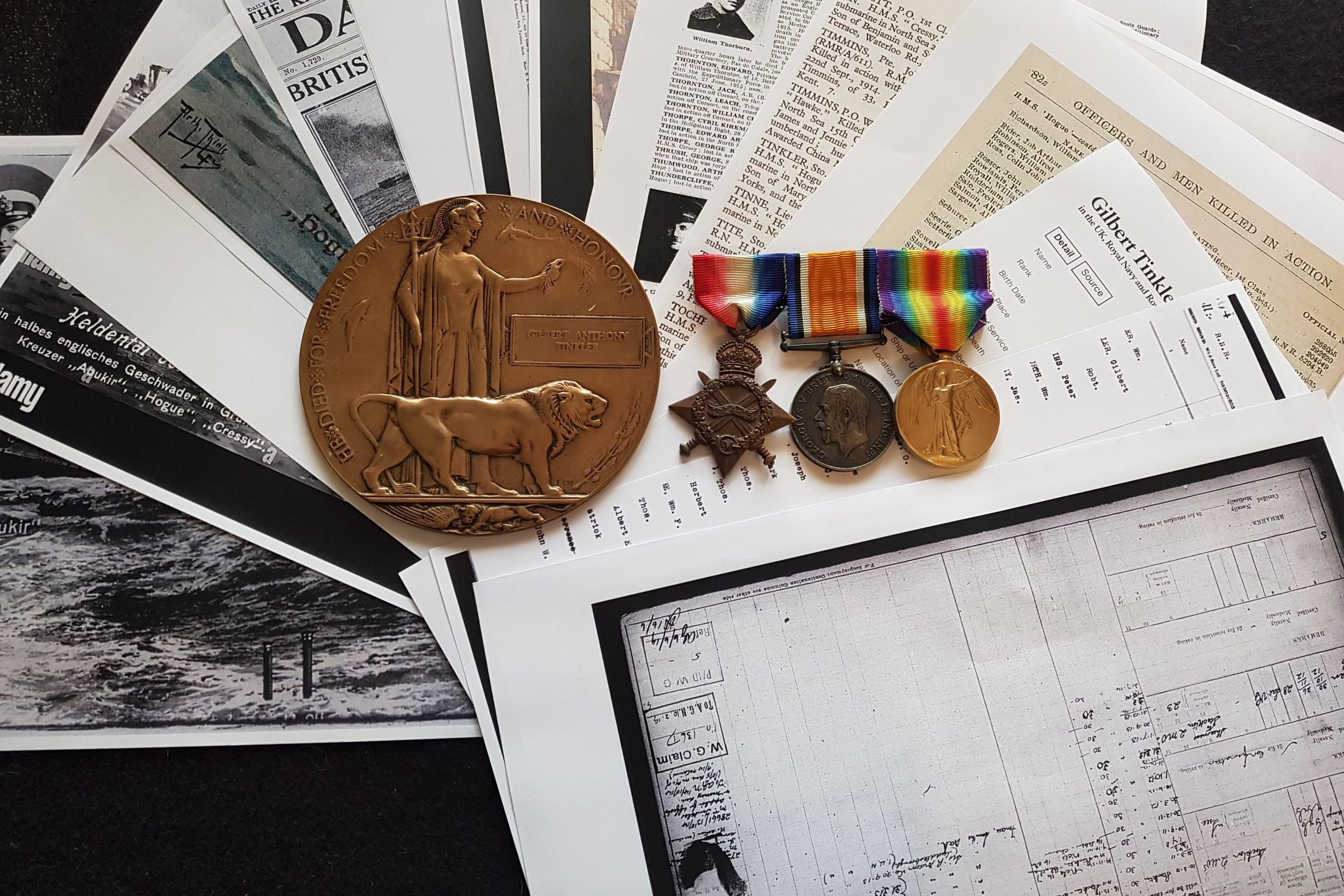A WW1 Royal Naval Reserve Casualty Death Plaque & Medal Trio, K.I.A. aboard H.M.S. Hogue during the famous actions of the 22nd September 1914, awarded to S1883 G.A. Tinkler (1527)
















![20240504_125409[1].jpg](https://images.squarespace-cdn.com/content/v1/5dfba30b57c6540cff43ba33/1714832814575-7ZVIUBZRC7OLH4VU9X3K/20240504_125409%5B1%5D.jpg)
![20240504_125557[1].jpg](https://images.squarespace-cdn.com/content/v1/5dfba30b57c6540cff43ba33/1714832884141-UX2PEUFRR6EDEN0O91JX/20240504_125557%5B1%5D.jpg)
![20240504_125617[1].jpg](https://images.squarespace-cdn.com/content/v1/5dfba30b57c6540cff43ba33/1714832917737-F2H4GSLG60M87DG12KHI/20240504_125617%5B1%5D.jpg)
A WW1 Royal Naval Reserve Casualty Death Plaque & Medal Trio, K.I.A. aboard H.M.S. Hogue during the famous actions of the 22nd September 1914, awarded to S1883 G.A. Tinkler (1527)
A WW1 Royal Naval Reserve Casualty Death Plaque & Medal Trio, K.I.A. aboard H.M.S. Hogue during the famous actions of the 22nd September 1914, awarded to S1883 G.A. Tinkler.
Gilbert Anthony Tinkler was born at Thornaby, Yorkshire, on the 22nd of September 1891. Tinkler joined the Royal Naval Reserve on the 1st of March, 1911, and he served aboard the armoured cruiser H.M.S. Hogue. This vessel played a reservist role in the Battle of Heligoland Bight towing H.M.S. Arethusa back to port after the fighting. However, on 22 September 1914 she was one of the three warships to suffer the attentions of U-9 under the command of Kapitänleutnant Otto Weddigen. The Hogue was the second of the cruisers to be hit by a Torpedo, shortly followed by a second and she capsized within ten minutes and sank within twenty. Notably Hogue was possibly the only vessel to have fired on its attacker as the loss of weight caused by firing two torpedoes in quick succession caused U9 to briefly surface. She lost nearly 400 of her compliment in the disaster which claimed over 1400 of the Squadron's, largely reservist, crews. Weddigen was awarded the Iron Cross 1st and 2nd Classes, latterly adding a Pour le Merite for the sinking of the Hawke. He was killed in action on 22 March 1915, when his new charge U-29, was rammed and sliced in half by the Dreadnought in the Pentland Firth.
The following in an online account the famous action -
On the morning of 22 September, Hogue and her sisters, Aboukir and Cressy, were on patrol without any escorting destroyers as they had been forced to seek shelter from bad weather. The three sisters were in line abreast, about 2,000 yards (1,800 m) apart, at a speed of 10 knots (19 km/h; 12 mph). They were not expecting submarine attack, but they had lookouts posted and had one gun manned on each side to attack any submarines sighted. The weather had moderated earlier that morning and Tyrwhitt was enroute to reinforce the cruisers with eight destroyers.
U-9, commanded by Kapitänleutnant Otto Weddigen, had been ordered to attack British transports at Ostend, but had been forced to dive and take shelter from the storm. On surfacing, she spotted the British ships and moved to attack. She fired one torpedo at 06:20 at Aboukir that struck her on the starboard side; the ship's Captain thought he had struck a mine and ordered the other two ships to close to transfer his wounded men. Aboukir quickly began listing an capsized around 06:55. As Hogue approached her sinking sister, Captain Wilmott realized that it had been a submarine attack and signalled Cressy to look for a periscope although his ship continued to close on Aboukir as her crew threw overboard anything that would float to aid the survivors in the water. Having stopped and lowered all her boats, Hogue was struck by two torpedoes around 06:55. The sudden weight loss of the two torpedoes caused U-9 to broach the surface and Hogue's gunners opened fire without effect before the submarine could submerge again. The cruiser capsized about ten minutes after being torpedoed as all of her watertight doors had been open and sank at 07:15.
Cressy attempted to ram the submarine, but did not hit anything and resumed her rescue efforts until she too was torpedoed at 07:20. She too took on a heavy list and then capsized before sinking at 07:55. Several Dutch ships began rescuing survivors at 08:30 and were joined by British fishing trawlers before Tyrwhitt and his ships arrived at 10:45. The combined total from all three ships was 837 men rescued and 62 officers and 1,397 ratings lost. Hogue lost 377 men.
In 1954 the British government sold the salvage rights to all three ships to a German company, and they were subsequently sold again to a Dutch salvage company which began salvaging the wrecks' metal in 2011
The medals are mounted for display, on original ribbons, sold with copied research, and are as follows –
1914/15 Star, S.1883 G. TINKLER.STO.’R.N.R.; British War Medal, 1883SG. TINKLER. STO. R.N.R.; Victory Medal, ERRASED original
Condition, good very fine
Plaque – GILBERT ANTHONY TINKLER
Condition, polished, thus good fine